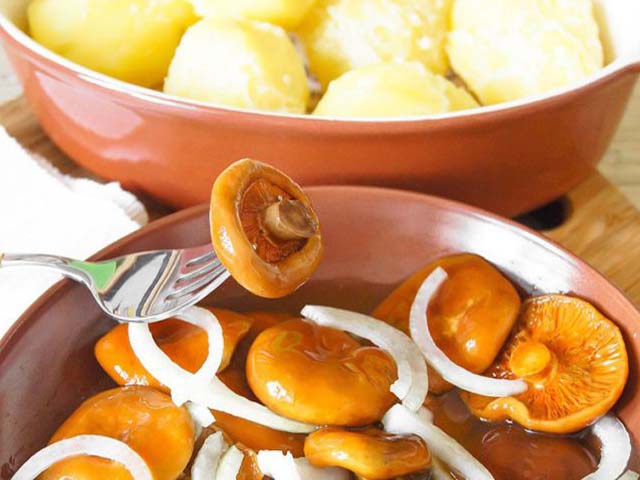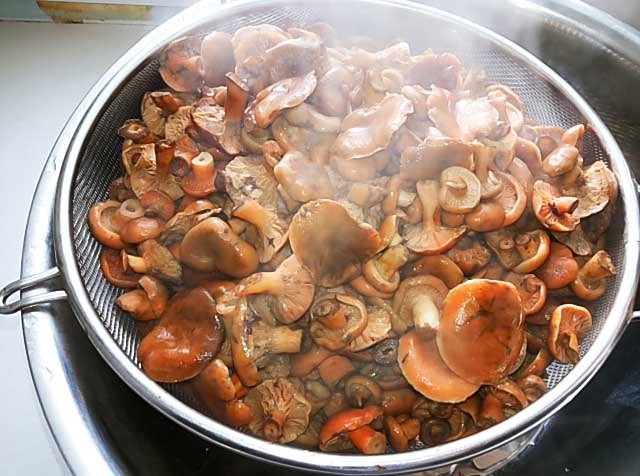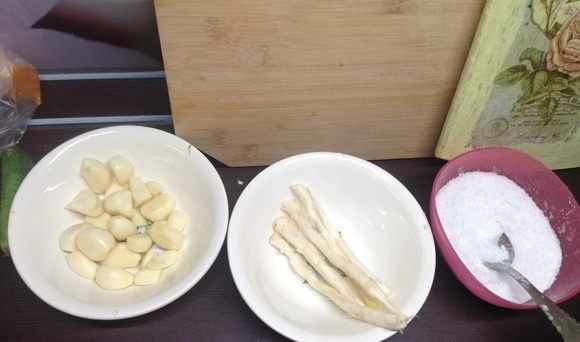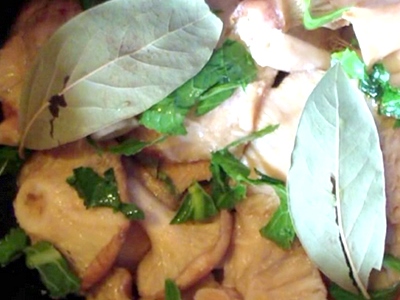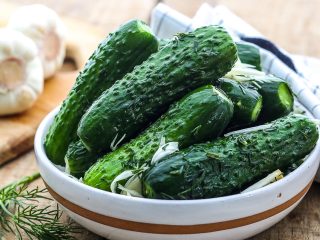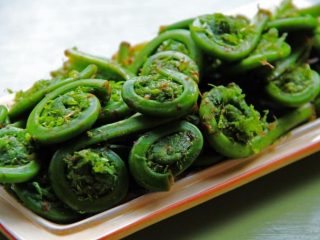Content
Any experienced mushroom picker will agree that the taste of salted mushrooms is so good that even the famous milk mushrooms are inferior to it in this regard. Moreover, salting saffron milk caps is not such a complicated procedure. But saffron milk caps, under pressure, just by their very appearance activate intense salivation in those who have ever tried such a preparation.
Features of salting saffron milk caps under pressure
There are many different ways to pickle mushrooms. True, in essence, they all come down to two main ones: cold and hot. Cold salting is carried out without preliminary heat treatment, that is, raw mushrooms are used. In the case of saffron milk caps, we went even further. Only these mushrooms can be salted not only raw, but without even soaking or washing them in water. This type of salting is called dry salting. You cannot do without oppression at all; it is this that helps the mushrooms release the required amount of juice.
True, the method is only suitable for very young mushrooms, with a cap diameter of no more than 5-7 cm, which, moreover, must be freshly picked. Therefore, it is not recommended to dry-salt purchased saffron milk caps, because you can never know exactly when they were cut. In addition, saffron milk caps for dry salting should be collected exclusively in environmentally friendly places, away from any roads; this is especially important.
When using regular cold pickling, the saffron milk caps are first thoroughly washed in water.
It is believed that when using both of these methods of cold pickling, saffron milk caps change their color, becoming dark.
Although this fact does not in any way affect the taste of the finished mushrooms, many do not like the look of dark saffron milk caps purely from an aesthetic point of view. And they believe that the only way to avoid darkening of mushrooms is to use hot pickling.
This is not entirely true, although hot salting can indeed preserve the attractive light shade of salted saffron milk caps. Oddly enough, but according to some data, saffron milk caps darken precisely because of contact with cold water. Therefore, with careful use of the dry salting method, saffron milk caps are quite capable of remaining very attractive in appearance. Moreover, the mushrooms will turn out incredibly crispy and will retain the unique spirit of the forest and pine litter.
Among the saffron milk caps themselves, there are two subspecies, slightly different from each other in appearance. Mushrooms collected in a pine forest are characterized by a special density, a thicker stem, with the brim of the cap closed downward. These saffron milk caps are ideal for any type of pickling under pressure and will remain beautiful and strong, even if not the smallest sizes are used.
The saffron milk caps growing in spruce forests have a finer structure, and their size is important for pickling under pressure. After all, large mushrooms will need to be cut into several parts. And, most likely, the hat will not withstand such tests and will crumble. This fact will not affect the taste in any way, but the appearance of the workpiece will become less presentable.
How to pickle saffron milk caps under pressure
Regardless of the choice of salting method, the saffron milk caps must in any case be sorted out, discarding broken or wormy ones. You also need to free them from remnants of pine needles and stuck leaves and other forest litter. True, saffron milk caps usually do not cause mushroom pickers much trouble in cleaning them. A certain amount of plant debris can accumulate only in the central recesses of the cap. They are also rarely wormy, so this procedure can be dealt with quite quickly.
Regardless of the chosen method of pickling saffron milk caps, it is imperative to keep them under pressure during pickling, especially in the first stages of the process. Because it is oppression that allows you to maintain the required level of liquid in the container with salted mushrooms. And the quality of the pickled mushrooms depends on this.
Cold way
This pickling method is very popular for all tubular mushrooms, since it allows you to preserve all the beneficial substances and does not require any heat treatment.
In addition, it is somewhat convenient and familiar to most mushroom pickers. After all, mushrooms brought from the forest are simply dipped into salted water.And in this state, all forest debris is separated very quickly. In addition, uninvited guests in the form of worms also do not like salt water and will very quickly leave their habitats, leaving the mushrooms clean.
Then the mushrooms are laid out on a horizontal surface covered with a towel to allow them to dry slightly.
During this time, prepare a container for pickling: a pan, bucket or jar. Salting mushrooms in jars is not very convenient precisely because it is difficult to choose a press that fits the size. Usually the salting process is carried out in large containers, and upon completion, the salted saffron milk caps are transferred to glass jars for storage.
Ryzhiki are such aromatic and tasty mushrooms that you should not use a lot of spices for pickling. Moreover, many people prefer to use only salt as a spice. Although traditional herbs, such as dill, horseradish, currant leaves and oak, can still play a positive role in preserving saffron milk caps from possible spoilage.
The washed saffron milk caps are laid out in layers in a container, sprinkling each layer with coarse salt (possibly adding dill seeds), not reaching a few centimeters to the edges. A clean piece of fabric is placed on top and pressure is applied to it. You can place any flat dish on top of the fabric to increase the area of pressure on the pickled mushrooms.
Containers of water are most often used as oppression, but you can also pick up a heavy flat stone. After all, using a flat oppression will allow you to cover the container with mushrooms with a lid, which will prevent foreign objects and insects from getting into it during the pickling process.
The mushrooms are placed in a cool place with a temperature of no more than + 10 ° C and kept in such conditions for two weeks. They need to be monitored and regularly (every 2-3 days) remove the pressure and fabric, wash them in hot water, or even replace the fabric with a new one. This is done to prevent souring and mold.
Within a few days, the mushrooms will release juice and settle significantly. If at some point another portion of saffron milk caps is brought from the forest, then they can be added to the already salted ones without fear. Of course, after preliminary cleaning and rinsing.
Hot method
Many housewives choose the hot method, despite the fact that it takes longer to produce. But the mushrooms are guaranteed not to change their color, and many believe that additional heat treatment will never be superfluous.
There are several types of hot salting of saffron milk caps, and in any case it is better to use pressure for all of them.
Most often, after cleaning, saffron milk caps are simply boiled in salted water for a quarter of an hour, after which they are salted in the same way as described in the cold method.
You don’t have to cook it, but simply pour boiling water over the prepared mushrooms, then drain the water and pickle the saffron milk caps in the same way.
And sometimes peeled saffron milk caps are placed in boiling water, to which the amount of salt and other spices required for pickling has already been added. They are boiled in this brine for about 10 minutes. Then they are packed tightly into jars and filled with hot brine. In this case, it is not necessary to use oppression, but for better soaking of mushrooms with brine, it is still necessary.
Salted saffron milk caps should be kept under pressure for at least 2-3 weeks, after which they can be transferred to jars, making sure that they are completely covered with brine.
Dry method
The dry method of pickling saffron milk caps is incredibly simple. Mushrooms are simply cleaned of debris with a brush without using water. Then they are placed in a prepared container, sprinkled with salt and the desired spices.
Then a cloth, plate or wooden circle is placed on top and a decent weight is placed. There should be enough salt, at least 30 g per 1 kg of mushrooms. Within a couple of hours, so much mushroom juice should be released in the container that the saffron milk caps will be completely immersed in it.
Salting of mushrooms takes place in a cool room with a temperature of no more than + 15 °C.
Recipes for saffron milk caps under pressure with step-by-step photos
To pickle saffron milk caps under pressure, you can use any of the recipes below.
Classic recipe for saffron milk caps under pressure
Required:
- 2 kg of saffron milk caps;
- 3 tbsp. l. salt;
- 3-4 dill umbrellas;
- cherry, currant leaves, juniper branches - optional.
Manufacturing:
- Mushrooms are cleaned of debris brought from the forest that is stuck to the caps, and the stems stained in the ground are cut off.
- Place a couple of dill umbrellas and a layer of saffron milk caps, legs up, on the bottom of an enamel pan, sprinkle with salt.
- The procedure is repeated until the mushrooms are gone.
- Leaves of dill and other spices are also placed on top as desired.
- Cover with a cloth, put pressure on it and send it to a cool place.
Spicy saffron milk caps under pressure
You will need:
- 3 kg of saffron milk caps;
- 3 tbsp. l. salt;
- a pinch of citric acid;
- 3 dill umbrellas;
- a bunch of parsley;
- 5 peas each of allspice and black pepper;
- 3 buds of cloves;
- 2 bay leaves.
Preparation:
- The mushrooms are placed in a container with salted water and thoroughly washed to remove all contaminants.
- The salty solution is drained, the mushrooms are placed in a saucepan, fresh water is added and boiled, skimming off the foam, for about 10-15 minutes.
- Place in a colander and leave to drain.
- Place in a suitable container, sprinkle with spices and salt.
- Spices and herbs are also laid out on top.
- Cover it with a cloth, put it under pressure and take it to a cold place.
Saffron milk caps under pressure with horseradish leaves
You will need:
- 1 kg of saffron milk caps;
- 2 tbsp. l. salts (incomplete);
- 4 cloves of garlic;
- 2 dill inflorescences;
- horseradish, cherry, currant leaves;
- 15 black peppercorns.
Preparation:
- The saffron milk caps are washed in water.
- Place them in a suitable container, gradually adding all the available spices.
- Cover the top with the remaining leaves.
- Cover it with a cloth, a bowl, and put pressure on it.
- Keep for a day at room temperature, then move to cool conditions.
How much saffron milk caps are salted under oppression
How long to keep salted saffron milk caps under pressure depends on which pickling method was chosen.
When using the hot method, mushrooms can be tasted within just a few days. But it is advisable to keep them under pressure for about 2-3 weeks.
If it was decided to salt the saffron milk caps under pressure using the dry method, then you can try them in about a week, although some do not wait until the allotted time. They will be able to be completely salted only after 1.5 months.
Finally, if pressed salted saffron milk caps are obtained as a result of cold fermentation, then they must be kept in this state for at least 1-2 months. And after that it is better not to remove the oppression, but to leave it for the entire time the mushrooms are stored.
Terms and conditions of storage
Camelina mushrooms salted under pressure can only be stored in a cold room at a temperature not exceeding + 10 °C. It’s even better that their storage temperature remains between + 3 °C and + 7 °C. In this case, the likelihood of souring of salted mushrooms will be minimized. You can preserve salted saffron milk caps under these conditions for a year.
Conclusion
Ryzhiki under pressure, prepared using any of the methods described above, will give you the opportunity to enjoy a fragrant and very tasty snack at any time. They will easily fit into the everyday menu and become a real highlight of the holiday feast.
